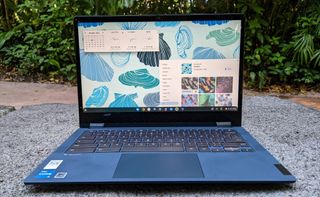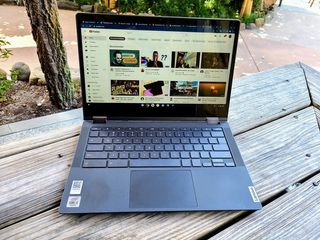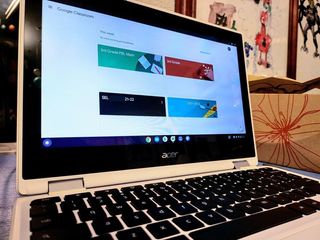It's too late Microsoft, Google beat you to dominate schools with Chromebooks

Microsoft's new Surface Go 3 "faces a long uphill battle" against Google's Chromebooks, especially in the U.S., where schools have adopted Google's easy-to-use system, experts say. They add that Microsoft has to make a compelling case to convince schools to use their systems, including better experience, integration, and better pricing models.
Microsoft announced the 10-inch 2-in-1 PC on Sept. 28. The convertible PC has different pricing tiers that start at $399 and can now be purchased through Microsoft's website or Amazon or Best Buy.
The Surface Go 3 is exactly identical to the Surface Go 2 except for the processing, which means that even though there are no new design changes, the new version is 60% more powerful than the entry-level Surface Go 2.
But Microsoft will face a tough challenge to try and beat Google at penetrating schools, says IDC's research manager of worldwide device trackers, Jitesh Ubrani.
"Microsoft faces a long uphill battle against Chrome, especially in the U.S. where many schools are entrenched in the Chrome ecosystem and have already placed orders for more Chromebooks in the coming years," he says.
As of Q2 2021, 74.1% of PCs and tablets shipped to the U.S. were Chrome OS, while only 16.6% were Windows, according to recent data from IDC.
Ubrani noted that Windows 11 was not a factor in the lower shipments of Windows PCs and tablets, "as the need for any type of PC remained quite high."
Be an expert in 5 minutes
Get the latest news from Android Central, your trusted companion in the world of Android
"Plus, any PC purchased now would likely be available for an upgrade to Windows 11," he adds.
Windows 11 rolled out publicly on October 4.
But much of that did come from the rise of COVID-19 and school closures moving into online learning.
A missed opportunity as pandemic cases decrease

Analysis from Trendforce notes that after Chromebooks were a "primary driver" of overall laptop shipments in the first half of 2021, those shipments are expected to drop by 50%.
As of Q2 2021, 74.1% of PCs and tablets shipped to the U.S. were Chrome OS, while only 16.6% were Windows, according to recent data from IDC.
And part of the reason for it to drop is because of the rise in vaccination rates in North America, Europe, and Japan, the report notes. Because of the increase in vaccination rates, kids and teachers are going back to in-person schooling, and parents are going back to the office.
It also means that not every person in a household requires a laptop urgently. It also means that schools are not rushing to buy laptops for every student doing online learning like they did last fall, particularly when Chromebooks were selling above list price because people were desperate.
Another reason that there could be a decline in devices could be because of Google's announcement in early January that all "devices launching in 2020 and beyond will receive automatic updates" for eight years. Chromebooks are now lasting twice as long as they did three to four years ago, so normally, when schools would have to purchase laptops every one to two years, they can now use them for twice as long.
Still, Trendforce cited in its report that laptop shipments will see a 16.4% year-over-year increase in 2021 for a total of 240 million systems.
Anshel Sag, a senior analyst at Moor Insights & Strategy, says that Microsoft should have been as aggressive as Google in those early days and "should've given away as many systems as they could to schools that were in need."
"Chromebooks are successful because they're inexpensive, simple, and easy to manage," he says.
Chromebooks are easy for teachers and IT departments, 'the same can't be said about Windows'

More importantly, Sag adds that if Microsoft wants to break into what Google achieved, it needs to make its Surface Go 3 more "teacher-friendly."
"I think Microsoft needs to make Surface Go 3 and all of its education-focused products more teacher-friendly and possibly work on improving manageability in class so that IT doesn't have to get involved to help solve students' problems," he says.
Sag notes that where Google succeeded is in making that management process simple and easy for teachers and IT departments at schools.
"Google has made things very easy to manage for teachers as well as IT managers with simple web interfaces and has built a pretty robust ecosystem of partners for deployments, support, and added features to benefit teachers," Sag says. "Partners like Mobile guardian and features like live screen views, which allows teachers to see what students are looking at in real-time as well as features like eyes up to get students attention when they need it."
IDC's Ubrani agrees and adds that Google has just made it easy to deploy Chrome and that the "same can't be said about Windows."
He notes that the added benefit is the lack of reliance on Microsoft Office, which can carry a hefty price tag for everyone involved.
Microsoft needs to offer better pricing options

While the new Surface Go 3's cheapest option is only $399, and it is a touch screen so you can use your fingers for optimal use, you still have to buy a Surface Pen and Surface Pro Signature Keyboard. The two together cost $280, so in total, you're spending $679. That said, you might not necessarily need the pen, but you definitely would want to get a keyboard.
Compared to the best Chromebooks in the market, you could get a Lenovo Chromebook Flex 5 for $375. The laptop has a 360-degree hinge for easy conversion to tent or tablet mode, and Android Central's Ara Wagoner says this laptop is one of the best Chromebooks in the market that "offers power and productivity for less."
Google also knows the value of not including a keyboard with its product, which was clearly seen with the demise of the Pixel Slate that was announced in October 2018 and discontinued in the three countries it launched in after two years.
Eight months after the launch of that tablet, Google confirmed it was stepping out of the tablet market and will focus on laptops only. This means any device that "detaches completely from a keyboard base or doesn't even have a physical keyboard in the first place."
And Sag agrees that if Microsoft wants to market to schools, it has to reduce prices and make the Surface Go line much more affordable.
"[Microsoft] has to approach education more deliberately and account for the teacher and school budgets and the probability of devices breaking on students," he says. "Chromebooks are simpler machines with a narrower focus, and I think that Microsoft is moving towards this with the Surface Go series, but I think the company needs to focus even more on bringing down cost and improving the total experience for everyone."
Ubrani says that Microsoft needs to "shed the image" of selling a piecemeal product where the tablet, keyboard, and pen must be purchased separately.
Google makes it so easy with Docs, Classroom, Drive, and Gmail, a feat Microsoft should've prioritized with Office Suite

Neil Shah, partner and vice president of research at Counterpoint Research, says that one of the most compelling reasons Google has dominated schools is the strong adoption of Google Suite (Docs, Drive, and Gmail) and, more recently, Google Classroom.
"Upgrading to affordable Google Chromebooks was thus a no-brainer for the school system versus the enterprise leadership of Microsoft with Office," he says.
It's worth adding that Google Suite is now known as Google Workspace, and Google Classroom has been part of Workspace for education. The service received a major redesign in 2018 and increased in adoption in the last couple of years.
If Microsoft really wanted to compete, it should make its products cheaper or subsidize its Office Suite, Shah says.
"Microsoft should have pushed subsidized or a free version of Office Suite and thin cloud-driven hardware with a partner or their own Surface line up as it was a blue ocean of underserved opportunity," he says.
"Microsoft should have pushed subsidized or a free version of Office Suite and thin cloud-driven hardware with a partner or their own Surface line up as it was a blue ocean of underserved opportunity," Neil Shah says.
Shah adds that Microsoft has for so long focused on a more "enterprise-centric design," whereas Google has been more "easy to use with a consumer-centric" focus.
He says that per Counterpoint's data, an estimation of 50 million Chromebooks are being used today in Education and Google Classroom, and Docs has users in hundreds of millions.
Carolina Milanesi, president and principal analyst at Creative Strategies, notes that because Chromebooks are a low-cost solution with user-friendly software that penetrated schools at a time when teachers and schools had no idea what to expect with the pandemic.
"The biggest hurdle for Microsoft is the reluctance for schools to move away from Chromebooks because they do not want to retrain teachers," she says. "Of course, all Google's tools could be accessed through Chrome on a PC, but the selling point Google has is to integrate the experience natively on a Chromebook."

Shruti Shekar is Android Central's managing editor. She was born in India, brought up in Singapore, but now lives in Toronto and couldn't be happier. She started her journalism career as a political reporter in Ottawa, Canada's capital, and then made her foray into tech journalism at MobileSyrup and most recently at Yahoo Finance Canada. When work isn't on her mind, she loves working out, reading thrillers, watching the Raptors, and planning what she's going to eat the next day.
